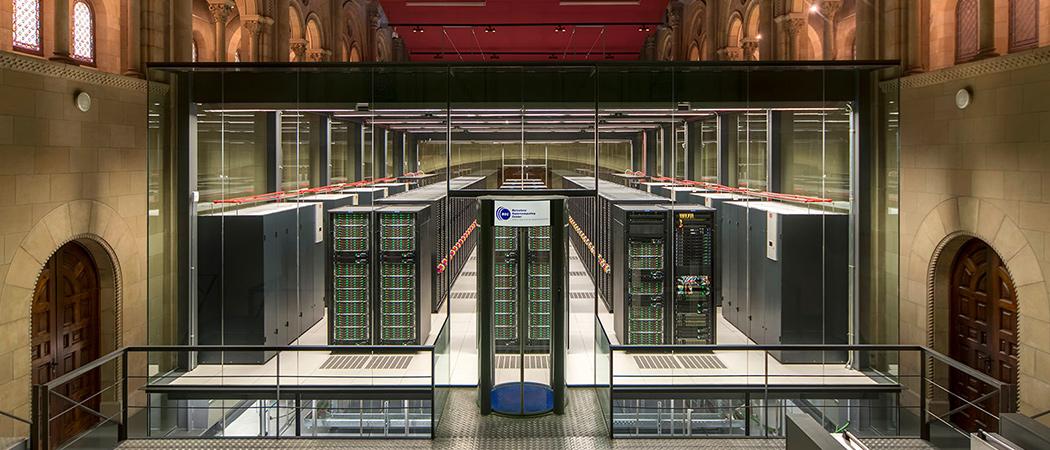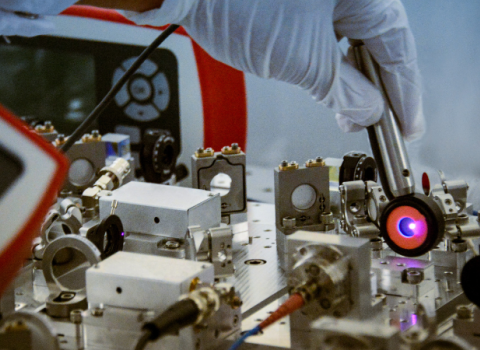Six quantum computers are to be built at supercomputer sites around Europe, in a bid to keep the EU at the forefront of this critical technology

The MareNostrum 4 supercomputer in Barcelona, one of six selected to host a new European quantum computer. Photo courtesy of Barcelona Supercomputing Centre.
Six quantum computers that are to be installed at sites across the EU, are mainly for use in research but will also be open to start-ups and other companies, with the aim of stimulating the pan-European quantum ecosystem. At the same time, quantum-related clusters around each facility are expected to get a significant boost.
“These new machines will make it possible to foster the emergence of real use case applications, and take steps towards mature quantum computing in Europe,” according to the European Commission, which is putting up half the money for the new infrastructure.
The six machines, announced on 4 October, will contribute to the development of an ecosystem of quantum programming facilities, application libraries and a skilled workforce. In turn, this will open up quantum computing across industrial sectors.
Start-ups will be included in this. “As part of both French and European strategies for quantum computing, it’s been decided to support start-ups in helping them meet end users through national and European platforms,” said Sabine Mehr, chief quantum projects officer at the Grand équipement national de calcul intensif (GENCI) in France, which will be hosting one of the new computers. “In exposing their technologies to end users, they have a better chance to receive useful feedback on the devices and software environments they have developed and to adjust, in a co-design spirit.”
The quantum computers will be accessible remotely from anywhere in Europe, but hosting a device is expected to benefit local ecosystems. “It creates an environment that makes it much easier to create a company, to launch a new programme or to attract international investment,” said Josep Maria Martorell, adjunct director of the Barcelona Supercomputer Centre, another of the sites selected. “You have the facility, then you can attract brilliant people, and they attract new projects and money and companies, and that’s a virtuous circle.”
Host organisations across Europe
The selection of the sites was made by the European High Performance Computing joint undertaking (EuroHPC JU), an initiative of the EU, European countries and private partners, which coordinates and funds the development of supercomputers across Europe. It is providing half of the €100 million for the six quantum computers, drawing on the EU Digital Europe programme, with the rest to come from the 17 participating nations.
Martorell is quick to point out that this has involved a leap of faith at the national level. “For a government there is an extra effort to invest in something that will probably not provide short term results. So we welcome their commitment, in the framework of the ambitious QuantumSpain initiative.”
The sites are:
- IT4Innovations National Supercomputing Centre at the VSB Technical University of Ostrava, in Czechia;
- the Leibniz Supercomputing Centre at Garching bei München, Germany;
- the Barcelona Supercomputing Centre;
- GENCI at TGCC/CEA Bruyères-le-Châtel, Essonne, France;
- Cineca in Bologna, Italy;
- the Poznan Supercomputing and Networking Centre in Poland.
Behind most of the bids are consortia that will bring in experience from other projects and ensure that the benefits will be widely shared. The LUMI-Q project in Ostrava is the largest, bringing together 14 partners from nine member states. Some, including the host, are relatively new to quantum computing, while others involved in LUMI-Q have considerable experience. In particular, it involves the teams who have been running the Helmi quantum computer together with the LUMI supercomputer in Finland.
Meanwhile the projects in Italy, France, Spain and Poland coordinated their bids to follow the principles laid out in the Quantum Flagship’s European Quantum Computing and Simulation Infrastructure (EuroQCS) whitepaper. These four consortia will bring together around 20 experts in a support team that will for example, help users port their work onto the different hardware technologies, and promote training and dissemination of results.
The six quantum computers are intended to be complementary, covering the breadth of current approaches to quantum computing. And they will all work as hybrids with their respective supercomputers, with the aim of smoothing the from one transition from one technology to the next.
While these may beat classical computing in some domains, or for some algorithms, the main aim is not to produce a machine with true quantum advantage, that outpaces classical computers.
“It is primarily a step forward in developing a quantum computing environment that will contain everything for our partners and users, including commercial users, to efficiently use the quantum computer,” said Branislav Jansik, director of supercomputing services at IT4Innovations and coordinator LUMI-Q project. “So, the focus is to provide a computer where they can carry out proof-of-concept work, and maybe even get close to a quantum advantage.”
Industrial involvement
The Commission has committed to the six quantum computers consisting entirely of European hardware and software, leveraging European technology developed under EU-funded quantum initiatives, national research programmes, and private investment. This means that European companies, including start-ups, will benefit from stimulus of the construction phase.
Details of who builds what will be settled in the subsequent commissioning process, although some companies are already involved. Creotech Instruments, based near Warsaw, is part of the EuroQCS-Poland consortium, and Finnish quantum computer start-up IQM Quantum Computers is building a precursor machine for the Leibniz Supercomputing Centre.
For Jan Goetz, chief executive and co-founder of IQM, this initiative is a significant moment in the European quantum story. “The quantum ecosystem will directly and indirectly benefit, with the acceleration in innovation (around hybrid algorithms, software and tools for controlling quantum processing units, control electronics, and so on), technology availability for start-ups, and capability building,” he said. “It will also create many new jobs.”
Arrangements for accessing the quantum computers are expected to be similar to those for EuroHP supercomputers, with open science projects from public and private users competing for free use on an equal footing, and some time also set aside for industrial projects. Meanwhile, partners who are making a financial contribution to a project will also be able to offer time to commercial users, if they choose.
“IT4Innovations has that mechanism in place for its supercomputer, and we will be looking for ways to extend that for the quantum computer as well,” said Jansik.
However, the process may not be quite as simple as logging onto a supercomputer and using the time allocated. “These are more like experiments than commercial machines, so every time someone wants to run a new code, it is probable that something will need to be changed on the machine,” said Martorell, “It will probably not be necessary for the scientists to come and do it themselves, but we will have to have very strong operations team at the centre to interact with the scientists and with the machine.”
Within the LUMI-Q project, there will be a particular emphasis on the three supercomputers in the project consortium: Karolina at Ostrava, in Czechia; LUMI at Kajaani, in Finland; and a supercomputer currently being built at the Cyfronet Academic Computer Centre in Krakow, Poland.
“The users of these computers will be able to work with the quantum computer as if it is local, without feeling any difference and without the inconvenience of having to come to a different computing centre,” Jansik said. Afterwards, the connection may be extended to other supercomputers in Europe.
It is also expected that LUMI-Q will be able to work with other quantum computers. “The software stack is designed in such a way that, in principle, it could easily be extended to target not just our computer, but other quantum computers. So, it will provide for integration with the other computers, extending the possibilities for users,” said Jansik.
Local ecosystems
Some of the sites already have considerable quantum communities around them, and one – GENCI in France – is already building a quantum computer. It is one of two sites involved in the High-Performance Computer and Quantum Simulator (HPCQS) project, a hybrid system also organised by EuroHPC. Quantum technology for the project is being provided by Pasqal, a spin-off from the Institut d’Optique in Paris.
Now GENCI will commission a second quantum computer, EuroQCS-France, in a consortium with University Politehnica of Bucharest in Romania, Forschungszentrum Jülich in Germany, and the Irish Centre for High-End Computing.
The Leibniz Supercomputing Centre (LRZ) is already working on a quantum demonstrator, called Q-Exa, which will lay the foundations for its new quantum machine, Euro-Q-Exa. It is also part of a broader regional initiative, the Munich Quantum Valley, set up to develop the local ecosystem, including encouraging start-up creation and relocation.
“We’re just at the start of Euro-Q-Exa, but we can say for sure that Munich and Bavaria have already established a very solid quantum computing ecosystem to work with,” said Dieter Kranzlmüller, chair of the LRZ’s board of directors. “As LRZ, we bring strong models for high-performance computing and industry to the table, including start-ups. We will leverage this existing experience and develop successful models to incorporate those into our industrial outreach and access for Euro-Q-Exa.”
In Barcelona, hosting the MareNostrum supercomputers has already demonstrated a catalytic effect on the local ecosystem, which Martorell is hoping to see repeated in quantum. “We have the beginnings of a small ecosystem here around quantum, so perhaps in five to seven years there should be something stronger.” In addition to the Barcelona Supercomputing Centre, the EuroQCS-Spain project involves the Institut de Física de Altes Energies in Barcelona, and the International Iberian Nanotechnology Laboratory, in Portugal.
In the case of Ostrava, the local quantum ecosystem is only just beginning. Hosting the facility is expected to help it develop. “There are some slight technical advantages to having the quantum computer in Ostrava, but they are not as significant as the psychological advantages,” Jansik said. Quantum computing will have increased visibility, and draw greater interest from the academic community in Czechia. “It will be easier to exchange knowledge locally, and to foster experts and expertise, so it has the potential to create a strong local environment focused on quantum computing and quantum computing algorithms.”
Elsewhere in the Ecosystem…
- Explainable AI company QuantPi, a spin-off from the Helmholtz Centre for Information Security and Saarland University, has raised €2.5 million in pre-seed funding. The company has developed a software platform that allows enterprises to ensure that commercial, legal, and reputational risks related to their artificial intelligence products and services are identified, assessed, and mitigated. The round was led by Capnamic Ventures, with participation of First Momentum Ventures.
- Sista, a Paris-based non-profit that lobbies to raise the profile of female entrepreneurs, has started its own venture capital fund. The ambition is to raise €100 million to invest in early-stage start-ups with at least one woman co-founder, in France and abroad. Areas of interest include fintech, healthtech, software as a service, and consumer focused start-ups.
- Patent fillings for space-based environmental sensing applications are booming everywhere but Europe, according to a study by the European Patent Office, European Space Agency, and European Space Policy Institute. Looking at international patents in this sector, European filing activity between 2001 and 2020 was approximately a quarter of that for the rest of the world, a figure that drops even further if the huge number of Chinese domestic patents is taken into account. And while European patent filings have stagnated in the last decade, the number of patent applications each year by non-European applicants has doubled.





 A unique international forum for public research organisations and companies to connect their external engagement with strategic interests around their R&D system.
A unique international forum for public research organisations and companies to connect their external engagement with strategic interests around their R&D system.